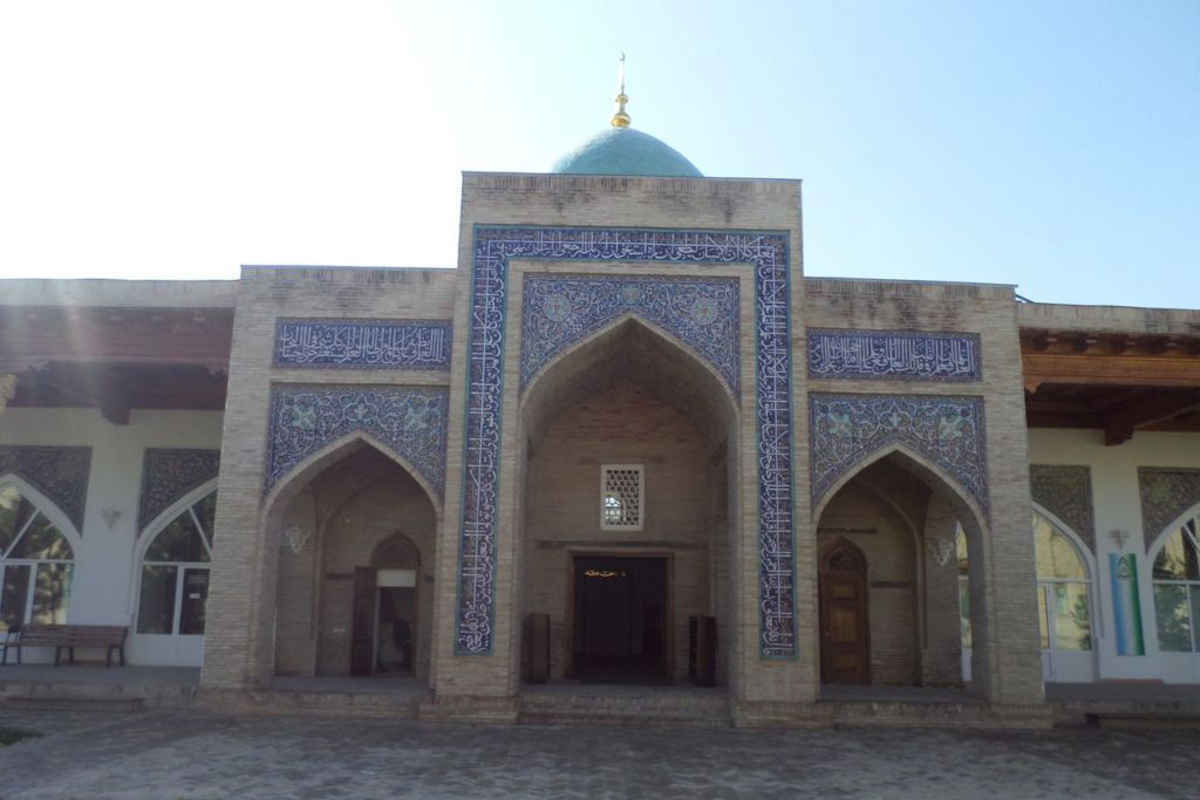Tashkent - Namozgoh Mosque
Namozgoh Mosque is a part of the famous Islamic centre of Tashkent, Hast Imam Square, which in the past served as a land area where people gathered during the great religious festivals.
The construction of the whole religious complex began in the XVI century, its present part is the mausoleum of Abubakr Muhammad Kaffal Shashi, the most revered Imam in Tashkent. The holy square was also named after him.
The Namozgoh Mosque was built in 1865 and has since been the largest mosque in Tashkent, where prayers are held on the holidays of Ramadan and Kurban Hayit. Since 1971 it has housed the Islamic Institute of Tashkent. In recent years, this architectural monument has undergone some minor changes.

The Namozgoh Mosque in Tashkent was later rebuilt as the Hazrati Imam Mausoleum, the Muyi-Muborak Medrese and the Barakkhan Medrese, which were built in the XVI century. The construction of the mosque lasted from 1845 to 1865, before Tashkent was conquered by Russia, it was built for the Khans of Kokand who conquered the city in the same century.
The ruler of the Kokand Khanate in the mid-19th century was Khudoyar Khan, whose lineage goes back to the Uzbek dynasty of the Ming Dynasty. His reign saw ups and downs, loss and restoration of power. Tashkent joined the Kokand Khanate in 1807-1808 years before Hudojar-khan ascended to the throne, but this is precisely when the construction of the Namozgoh shrine began in 1845 after his first accession.
The construction of the place of worship lasted until 1865, after which war broke out between Russia and Kokand and the city was captured by Russian troops led by Lieutenant Colonel Mikhail Chernyaev. The mosque was not destroyed despite the hostilities and one could always come here to attend Friday or holiday prayers.
The mosque remained a place of worship until the revolution of 1917, when it was destroyed and looted. Restoration of the mosque only began in the 1970s and Sheikh Ziauddinhan ibn Eshon Babahan, who at the time was Chairman of the Spiritual Administration of Muslims of Central Asia and Kazakhstan, took control of the process.
In 1971, the Sheikh applied to the Soviet authorities for permission to open a college on the grounds of the shrine; it was immediately named after Imam al-Bukhari, who was a famous Islamic theologian.
The institute was established on the basis of the courses opened in 1970 for the advanced training of Imam Khatibs. During the Soviet period, the Institute was the only higher Islamic educational institution in the Soviet Union that trained Muslim clerics for the European part of the country, Central Asia, Siberia, Kazakhstan and the Caucasus.
After the collapse of the Soviet Union, the educational institution on the grounds of the shrine was renamed the “Islamic Institute of Tashkent” and is now under the administration of the Muslims of Uzbekistan. Since the 2000s, graduates of the institute have been awarded a bachelor’s degree.
The institute trains Imame-Khatibs, Islamic scholars and teachers of the Arabic language. Religious studies, political science, history of religions and history of Uzbekistan, ecology, a range of theological sciences, various languages, eloquence, literature and calligraphy are taught. Arabic and Uzbek are used in teaching.
The mosque is an elongated structure, at the moment it faces the courtyard of the institute, its dimensions are 56 by 15 metres, the traditional oriental style was used for its design. The sanctuary is crowned by a blue dome that extends to the sky and is decorated with patterned window grilles made of ganch and ornamental painting. The winter premise of the sanctuary is the cruciform hall overlapping a high dome on either side, from which two rows of four-bay arched dome galleries extend. Parallel to them, the column aivan is spanned by a tree.
The builders used burnt bricks to construct the walls of the mosque. The decorations of the interiors are missing, the only detail being the mihrab niche of the main hall, it is shallow and has small dimensions, and stalactite mukarnas in the arch. The vault itself is decorated with a carved panjara.
For many years, locals have passed on the legend that the golden hair of the Prophet Muhammad lies within the walls of the sacred place. This story enjoys great popularity and attracts crowds of tourists from far away to the mosque, as well as pilgrims from all parts of the world. Every year, the shrine is visited by thousands of religious people who want to hear the sacred hadiths in person, but also to commemorate great thinkers and touch ancient history.
